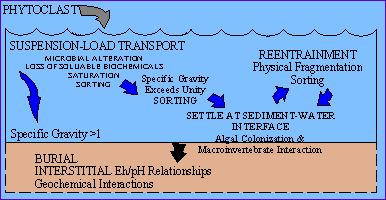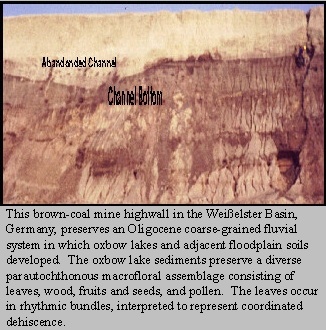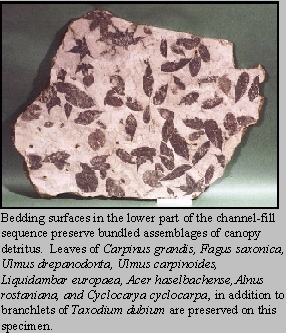BIOSTRATINOMIC PROCESSES IN FLUVIAL SYSTEMS
Distribution of living taxa is controlled by soil moisture, resulting in a mosaic vegetational pattern. Once introduced
into an aquatic setting, plant parts may undergo a variety of interactions before final deposition and burial.

Preservation Potential Along and Adjacent to River Channels
- Plants tolerant of wetland conditions occur in the back levee.
- Forest Canopy and subcanopy may be represented in those sites adjacent to the river channel, that is, the
levee and back levee.
- The arborescent plants tend to form a barrier to the movement of canopy detritus laterally.
- Detritus generated from Levee plants does not seem to be moved to the Back Levee (Burnham, 1989).
- The litter produced in one subenvironment represents that subenvironment.
- There is little or no dilution of the litter assemblages by contributions from other subenvironments.
The potential for preservation of canopy plant parts is dependent upon the microhabit within the river system
(Burnham, 1989).
- Channel Sediments - Slow water at a distance of 1-2 m from shore preserved abundant plant detritus in muds to
-0.45 m depth.
- River edge species comprise most of the taxa collected, rare contribution from the levee taxa.
- The percentage of local species found in these deposits ranges from 13-47%.
- FOREBANK SEDIMENTS - Leaf mats occur in fine muds, muds introduced during flood stages.
- Low diversity of vegetation due to standing water (river bank taxa).
- The percentage of local species found in these deposits ranges from 38-48%.
- LEVEE SEDIMENTS - The site is subaerially exposed, influenced by fluctuating water in the soil, heavily rooted
and, hence, there is poor potential for preservation.
- High diversity of living vegetation, but the percentage of local species found in the leaf litters ranges from
29-56%.
- BACK BANK SEDIMENTS - Leaf litters recovered from these sites were found in topographic lows in
water-saturated sites.
- The percentage of local species found in these deposits ranges from 36-58%.
Preservation Potential in Channel Cut-offs (Oxbow Lakes)

Gastaldo and others (1989) have evaluated the potential for preservation of plant detritus in a temperate oxbow in the
Alabama River floodplain, and have compared these empirical data to the Tertiary of central Europe (Gastaldo and
others, 1996; 1997).

- CHANNEL SEDIMENTS - Degradation of leaf detritus results in the development of stratified adpressions (term
used to describe both impressional and compressional state of fossil leaves) in the fine mud.
- Leaves are generally preserved where physico-chemical conditions have retarded bacterial colonization and
internal degradation of cell tissues.
- Woody tissues and resistant reproductive propogules (seeds, fruits, etc.) are easily recovered.
- The diversity of plants and plant parts is less than the diversity found in the forest floor litters produced
by the living vegetation (based upon the Holocene data set).
- The diversity of plant taxa in the fossil data set represented as macrofossils is less than the diversity as
determined from macrofloral (leaves, wood), carpological (fruits and seeds), and palynological (spores
and pollen).

- FOREBANK SEDIMENTS - Mats of leaf litter are preserved in a horizontal disposition
- Concentration of these leaves can occur by the action of waves moving towards the margin of the oxbow
lake. Large quantities of fragmented leaf material is then mixed with more resistant plant parts.
- LEVEE SEDIMENTS - The diversity of the living vegetation around Boatyard Lake is low to moderate.
- Subaerial litter degrades quickly with only the most resistant and woody sclerenchymatous parts recoverable
from the subsurface.
- Ends of linear woody fragments may be rounded (through biological degradation rather than mechanical
processes).
- Fluctuations in water table and the introduction of oxygenated waters provides little opportunity for
non-resistant plant part preservation.
- BACKSWAMP SEDIMENTS - These are areas in which standing water occurs for some time during the year
(dependent upon climate fluctuations). In the Holocene swamps, there is very low diversity of living vegetation
(Taxodium [Bald Cypress] and Nyssa [Tupelo Gum]). Similar data exist for fossil examples.
- Bedded leaves do occur in the subsurface and there is woody crown detritus recoverable.
- The assemblage of canopy parts in the forest-floor litter is unoriented (no preferential biotic or abiotic
orientation); this is also believed to be reflected in the subsurface.
BIOSTRATINOMIC PROCESSES IN LAKE SYSTEMS
Lakes, in contrast to unconstrained river systems, often
contain rich fossil plant assemblages due, in part, to episodic
high rates of deposition. The abundance and types of plant remains in lakes is a function of the distance and mode of
transportation, as well as the biological and mechanical degradation operating within the system at the time of transport
and burial.
- It has been demonstrated in several lake systems that the different types of plants may be either over-represented
(those that inhabit aquatic and waterside sites) or under-represented (those that live a short distance from shoreline
or some distance from the stream channels that feed the lake; Spicer, 1981, 1989).
- The arboreal component growing near the lakeside may be under-represented. This under-representation of
lakeside vegetation seems to be restricted to those plants that dominate the community. There are exceptions.
- Debris from shrubs and trees directly adjacent to the lake shore may be subjected to filtering by the
surrounding reed-marsh vegetation.
- The type of leaf may also play a role in the final fossil assemblage.
- Spicer notes that although Fagus (Beech) was well represented in stream deposits that fed Silwood
Lake, England, that in the lake proper, only the smaller (sun) leaves were found.
- THERE IS NO SIMPLE DIRECT RELATIONSHIP BETWEEN THE DEPOSITED REMAINS AND THE
SOURCE VEGETATION.
Where several streams enter into a lake basin, each may provide a different suite of plant parts to that depositional site.
- Spicer & Wolfe found that in Claire Engle Lake, California, when small delta deposits at the end of all 6 streams
entering the lake drainage sites were examined, all forest dominants were well represented.
- Some members of the forest were over-represented.
- Those plants immediately adjacent to the drainage system are well represented.
- Co-occurrence of plant parts from the same plant happens when the settling velocity of the parts is similar.
This is not often the case.
- More often, leaves are transported greater distances than other denser parts.
- Relative abundances of source vegetation are not accurately reflected in the relative abundances of plants in the
sediment samples.
Isolated Lakes may act as sites for the deposition of peat (dark-brown or black residuum produced by the partial
decomposition and degradation of wetland plants).
©
Copyright 1997-1998 by Robert A. Gastaldo. All rights reserved. No part of
these lecture notes may be reproduced or transmitted in any form or by any
means, electronic or mechanical, including photocopy, recording, or any
information storage and retrieval system, without permission from the
author.





